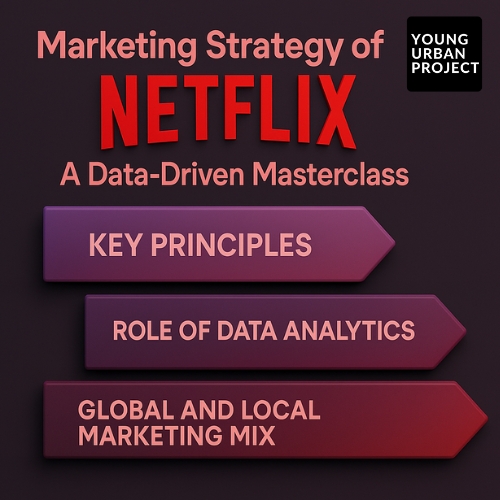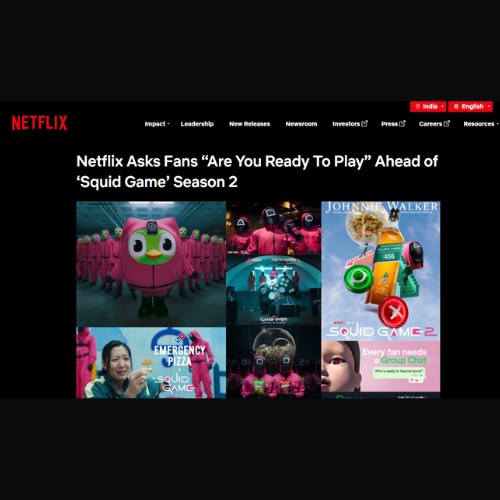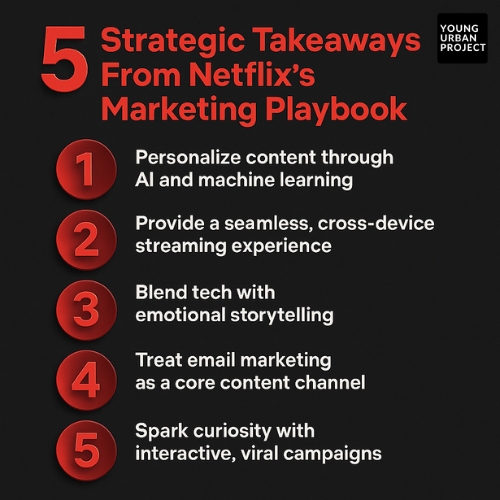How do you turn movie nights into a global habit—and make more than 300 million people feel like the story was written just for them? Netflix didn’t just ride the wave of change; it made the wave. What began as a DVD-by-mail service quietly dismantled an entire industry and reshaped how we watch, feel, and talk about entertainment. From killing off late fees to creating binge-worthy obsessions, Netflix built more than a brand—it built a culture. In this Netflix Case Study, we dive into the powerful marketing strategies, innovative decisions, and bold storytelling that made Netflix the world’s favorite screen companion.
Table of Contents
Netflix’s Rise to Streaming Supremacy
Netflix started in 1997, shipping DVDs in red envelopes. It was simple, convenient, and just different enough to stand out. But what really changed the game was when they went digital.
Today, Netflix is available in 190+ countries, offering a mix of global hits and local gems. What began as a humble rental service is now a billion-dollar brand with original shows, data-driven tech, and a fiercely loyal fan base.
Who Is Netflix’s Target Audience?
Netflix uses multiple segmentation strategies to personalize everything:
- Demographic: Age, gender, education, income
- Geographic: Language, culture, location
- Psychographic: Lifestyle, interests, social values
- Behavioral: Watch time, genres, device usage, past behavior
Demographic Segmentation
1. Age: Most Netflix users fall between the ages of 18 and 39. These are the binge-watchers, the meme-makers, the weekend warriors curled up with a show until 3 a.m. Millennials and Gen Z love Netflix for its endless scroll and on-the-go streaming. That said, the 50+ crowd is also tuning in more than ever, especially with new content made just for them.
2. Gender: Netflix hits both genders, though women make up a slightly larger share of subscribers—especially for dramas, rom-coms, and reality TV. Men tend to go for action, thrillers, and sci-fi.
3. Income: When it comes to income, Netflix is surprisingly inclusive. In the U.S., the average household income of a subscriber is around $100K. But with multiple plans (including ad-supported ones), people from different income brackets can jump in.
4. Education: Education-wise, college grads and working professionals make up a big chunk of the base. These are the folks who love deep-dive documentaries, foreign films, and buzzy limited series.
5. Geography: And geographically? Netflix is in over 190 countries. That means originals in Korean, Spanish, Hindi, and beyond. Subtitles, dubbing, and local stories make it feel personal—no matter where you live.
How They Think and What They Want
Netflix viewers value choice and control. They don’t want to wait for episodes to drop weekly—they want to binge. They watch on TVs, phones, tablets—sometimes all in one day. They look for stories that feel real, progressive, and different.
Interests range from anime and K-dramas to true crime and stand-up. Many are curious, socially aware, and open to content outside their comfort zone. They want to see diversity, real representation, and stories that reflect their world.
And behind the scenes, Netflix tracks what you watch, how long you watch it, and what you skip. That’s how it serves up content you didn’t know you’d love—and why your homepage looks different from everyone else’s.
In Short: Who’s Watching Netflix
| Segment Type | What It Looks Like |
| Age | Mostly 18–39, with growing 50+ viewership |
| Gender | Slight female majority; genre preferences vary |
| Income | Wide range; average U.S. household = $100K |
| Education | Many are college-educated, value smart content |
| Location | 190+ countries, tailored by region |
| Lifestyle | Binge-watchers, always online, on-the-go viewers |
| Values | Diversity, inclusion, fresh perspectives |
| Behavior | Watched-based recommendations, hyper-personalized |
Netflix’s success comes from knowing not just who is watching, but why they’re watching—and constantly evolving to meet those expectations.
Netflix’s Business & Revenue Model
1. Core business model:
Netflix operates on a subscription-based streaming model where users pay a monthly fee for unlimited access to the platform’s content library. This model eliminated the traditional pay-per-view approach, instead offering all-you-can-watch content with tiered pricing based on video quality and number of simultaneous streams allowed.
2. Revenue streams:
Monthly subscription fees form Netflix’s primary revenue source across their various pricing tiers. Additional revenue comes from partnerships with telecommunications providers who bundle Netflix with their services, and strategic licensing deals where Netflix content is sold to markets or platforms where they don’t directly operate.
3. Operational model:
Netflix runs on a distributed cloud infrastructure, primarily using Amazon Web Services for content delivery and streaming optimization. Their production arm, Netflix Studios, operates globally with direct investments in original content creation rather than merely licensing existing shows, allowing for greater control over their content library.
4. Strategic alliances:
Netflix maintains crucial partnerships with internet service providers to ensure quality streaming experiences, device manufacturers for native app integration, and content creators from major studios to independent producers. These relationships extend Netflix’s reach while securing exclusive content that drives subscriber growth.
5. Value proposition:
Netflix differentiates through three core offerings: exclusive original content unavailable elsewhere, a personalized user experience powered by recommendation algorithms, and ubiquitous accessibility across devices and locations. The ad-free environment and binge-release model cater to modern viewing preferences that traditional networks cannot match.
6. Competitor landscape:
Amazon Prime Video leverages its broader e-commerce ecosystem offering bundled benefits. Disney+ capitalizes on beloved franchises and family-friendly content. Hulu focuses on current-season television and live options. This growing competition has pushed Netflix to increase content spending and focus on international growth markets where streaming adoption is still expanding.
Marketing Strategy of Netflix: A Data-Driven Masterclass

1. Key principles:
Netflix’s marketing revolves around putting viewers and their experiences at the center, letting high-quality content drive customer acquisition rather than platform features, and making decisions based on user data rather than assumptions. Their campaigns emphasize emotional connections to stories rather than technical capabilities or price points.
2. Role of data analytics:
Netflix collects extensive viewing data to understand exactly what content resonates with specific audience segments. This data informs everything from personalized recommendations to which images appear as thumbnails for different users. Their testing approach extends to marketing, where campaign elements are continuously refined based on performance metrics rather than gut feelings.
3. Global and local marketing mix:
While maintaining a consistent brand identity worldwide, Netflix adapts marketing campaigns to reflect local cultural contexts. For major releases, they develop coordinated worldwide campaigns with market-specific modifications. Local marketing teams receive significant autonomy to develop region-specific promotions, recognizing that entertainment preferences vary dramatically across different cultures.
Also read: What Is Marketing Mix? The 4 Ps of Marketing
Netflix’s Digital Marketing Model
Netflix has mastered digital storytelling not just in shows, but in how it markets them. It runs multi-platform campaigns across social media, YouTube, and Google — targeting users with trailers, memes, teasers, and behind-the-scenes drops to build hype before launch day.
Main digital channels:
- Instagram, X (Twitter), Facebook, TikTok
- YouTube (official trailers, cast features)
- Influencer collaborations
- Paid ads (Google, Meta, programmatic)
Netflix invests heavily in performance marketing. Whether it’s a new series or a regional launch, they run data-backed paid campaigns optimized for clicks, views, and app installs. SEO also plays a role in ranking titles, actor interviews, and landing pages on Google.
With audiences in over 190 countries, Netflix uses geo-targeted content and promotions. That means language-specific trailers, subtitles, thumbnails, and even thumbnails tailored to regional viewer preferences. A user in Brazil sees a totally different version of a campaign than someone in the US.
Buzz-Worthy Campaigns
1. Squid Game:

Netflix’s “Squid Game” campaign asked fans, “Are you ready to play?” ahead of Season 2. With teasers, social media buzz, and immersive fan experiences, it turned anticipation into global engagement—showcasing Netflix’s mastery in gamified, suspense-driven marketing that taps into cultural moments.
2. Wednesday Addams Series:

Launched with TikTok dance challenges (#WednesdayDance) and dark humor meme reels. Millions recreated the dance, driving organic buzz before the finale dropped.
3. Heeramandi by Sanjay Leela Bhansali (India):

Paired high-end digital trailers with Bollywood influencer collabs and Instagram takeovers — dominating Indian digital conversations in days.

Enroll Now: Live Digital Marketing Course
Technological Innovations Behind Netflix’s Growth
Netflix doesn’t just stream content — it engineers one of the most advanced AI ecosystems in entertainment. Everything from your homepage to what’s trending is shaped by machine learning models designed to keep you watching just “one more episode.”
1. Personalization Through Machine Learning
Netflix uses powerful ML algorithms to predict what you’ll like based on your watch history, time of day, devices, and even how long you hover over a thumbnail. These models fuel your “Top Picks,” “Because you watched…” rows, and custom thumbnails.
2. Real-Time Data & Streaming Optimization
Behind the scenes, Netflix collects real-time viewing data from every device globally. It uses this data to optimize stream quality, reduce buffering, and manage server loads — making sure your binge never pauses mid-plot twist.
3. Seamless Multi-Device Experience
Whether you’re on a smart TV, tablet, phone, or gaming console, Netflix offers a frictionless viewing experience. It auto-adjusts resolution, remembers where you left off, and keeps UI performance consistent — a tech feat few platforms match.
How Netflix Leverages CRM & Retention Strategies
4 Core CRM Practices:
1. Intelligent content recommendations:
Netflix’s recommendation system analyzes viewing history, preferences, and behavior patterns to suggest relevant content to each user. This personalization increases engagement by reducing search time and introducing viewers to shows they might never discover on their own, creating a perception that Netflix understands their unique tastes better than competitors.
2. Personalized “Continue Watching” feature:
This prominent interface element removes friction by allowing viewers to instantly resume content exactly where they left off across any device. Beyond convenience, this feature creates a psychological commitment loop where unfinished shows generate a subtle completion urge, encouraging users to return to the platform regularly.
3. Free trials and onboarding journeys:
Netflix crafts strategic onboarding experiences that showcase content diversity within minutes of signup. New users receive carefully sequenced recommendations based on their initial selections, creating immediate value perception. Though Netflix has reduced free trial availability in mature markets, their signup process remains optimized for rapid engagement.
4. Massive, categorized content library:
Netflix organizes content into surprisingly specific micro-categories beyond traditional genres. These hyper-specific categories create the impression of endless discovery possibilities while making the massive library feel personally curated. This categorization strategy prevents the paradox of choice where too many options lead to decision paralysis.
- What CRM system does Netflix use?:
Netflix utilizes a proprietary CRM system built specifically for their needs rather than an off-the-shelf solution. This custom platform integrates viewing data, customer service interactions, payment history, and content preferences to create comprehensive user profiles that drive personalization across every touchpoint.
- Email marketing as a retention tool:
Netflix employs strategic email marketing that extends beyond transaction notices. Their email strategy includes new release announcements tailored to viewing history, personalized recommendations, and “we miss you” campaigns for lapsed viewers. Unlike typical promotional emails, Netflix’s communications feel like content updates rather than marketing, with high open rates resulting from tight relevance to individual preferences.
5 Strategic Takeaways From Netflix’s Marketing Playbook

1. Personalize content through AI and machine learning:
Netflix demonstrates that effective personalization goes beyond inserting a customer’s name into generic messages. Their algorithms create unique experiences for each user, from customized thumbnail images to individualized recommendations. This depth of personalization creates a competitive moat that’s difficult for competitors to overcome despite similar content offerings.
2. Provide a seamless, cross-device streaming experience:
Netflix prioritizes technical consistency across platforms, ensuring that users can start watching on one device and continue on another without friction. This device-agnostic approach acknowledges changing consumption habits where viewing might begin on a commute, continue at lunch, and finish at home, creating a service that fits modern lifestyles rather than expecting viewers to adapt to platform limitations.
3. Blend tech with emotional storytelling:
While Netflix employs sophisticated technology, they consistently frame their marketing around emotional connections to stories rather than technical features. Their campaigns highlight characters, plot tensions, and cultural moments rather than streaming quality or interface improvements. This storytelling approach creates deeper connections than feature-focused marketing.
4. Treat email marketing as a core content channel:
Netflix elevates email beyond promotional announcements by treating it as a personalized content delivery channel. Their emails function as curated viewing guides unique to each recipient, driving engagement by highlighting specific content of interest rather than generic platform promotions. This approach generates anticipation rather than the typical marketing fatigue.
5. Spark curiosity with interactive, viral campaigns:
Netflix designs campaigns that encourage active participation rather than passive consumption. From Black Mirror’s interactive episode to Stranger Things’ ARG-style scavenger hunts, they create experiences that extend beyond traditional marketing. These campaigns generate organic social sharing as fans discuss theories, discoveries, and experiences online.
Market Share & Global Expansion
Netflix remains a dominant player in the global streaming market, leveraging its vast international subscriber base and extensive content library. While exact current market share figures are not provided in the search results, Netflix’s global reach and content localization efforts have kept it competitive against rivals like Disney+, Amazon Prime Video, and HBO Max by appealing to diverse audiences worldwide.
1. Growth in Emerging Markets
Netflix’s phased expansion strategy—starting with culturally proximate regions before entering more diverse markets—has been a success. Countries across Southeast Asia, the Middle East, and Africa are seeing strong uptake, fueled by region-specific content and better language accessibility. This approach not only grows viewership but strengthens brand loyalty in new territories.
2. Localization of Content and Subtitles
Netflix’s localization efforts go far beyond basic translation, aiming to create a truly immersive experience for global audiences:
- Language Support: Offers subtitles in 33 languages and dubbing in 36 languages.
- TV Experience Update (April 2025): Viewers can now access any available subtitle or dubbing option on any title, regardless of region or profile settings—ideal for multilingual households and global viewers.
- Cultural Adaptation: From jokes and idioms to visual cues, Netflix fine-tunes content to resonate with local sensibilities.
- Region-Based Content Libraries: Curated blends of international hits and hyperlocal originals ensure broader appeal.
- Localized Interface and Metadata: Even genre tags, titles, and descriptions are tailored for each market to boost discoverability.
(Source)
Impact of Localization on Growth
Localization isn’t just a feature—it’s a growth engine. Shows like:
- “Money Heist” (Spain) and
- “Squid Game” (South Korea)
achieved worldwide fame thanks to Netflix’s commitment to high-quality dubbing, subtitles, and targeted marketing strategies. These titles started as regional hits but became global phenomena—demonstrating how smart localization converts content into cultural exports.
Product Offerings & Original Content Strategy
Netflix changed the game with its “Netflix Originals” — content it owns, controls, and distributes globally. These aren’t just shows; they’re brand assets driving loyalty and buzz.
1. Originals That Made Waves
From The Crown and Stranger Things to Squid Game and Berlin (Money Heist Universe), Netflix creates global blockbusters that transcend borders — and become memes, merch, and movements.
2. Local Content = Global Strategy
Netflix isn’t just exporting Hollywood; it’s investing billions into regional studios and talent. The goal? Turn local hits into global phenomena — like it did with Physical 100 and Fauda.
3. Discovery Built for Bingeing
UX is optimized to keep you exploring. Shows are categorized not just by genre, but by mood, pace, and vibe. Personal thumbnails, auto previews, and top 10 rankings all boost content discovery and watch time.
Corporate Social Responsibility (CSR)
1. Environmental sustainability:
Netflix has committed to reducing its environmental impact through their Net Zero + Nature plan. The company focuses on reducing direct operational emissions and addressing the carbon footprint of their content production. They’ve invested in renewable energy projects to offset emissions from their streaming infrastructure and studio operations, recognizing that digital entertainment has significant energy requirements.
2. Diversity in content and casting:
Netflix has made deliberate efforts to increase representation both in front of and behind the camera. Their inclusion initiatives support creators from underrepresented backgrounds and communities. Shows like “Bridgerton,” “Orange is the New Black,” and “Sense8” showcase diverse casting, while Netflix’s international content strategy naturally amplifies voices from different cultures and perspectives.
3. Ethical content policies:
Netflix maintains content guidelines that balance creative freedom with ethical concerns. They’ve implemented content warnings and parental controls while avoiding censorship. Their approach includes age-appropriate ratings, content descriptors, and tools that allow viewers to make informed choices. The platform takes responsibility for potentially triggering content while preserving storytelling integrity and creative expression.
Conclusion: What Brands Can Learn from Netflix
Summary of Netflix’s unique marketing advantage:
Netflix’s greatest strength lies at the intersection of data sophistication and emotional storytelling. While competitors may match their technical capabilities or content budgets, few combine analytical precision with compelling narratives so effectively. This balanced approach creates both rational value (personalization, convenience) and emotional connection (memorable stories, cultural moments), making the service difficult to replace in consumers’ lives.
Lessons for marketers, startups, and content platforms:
Netflix demonstrates that successful digital brands must embrace constant evolution rather than defending established models. Their willingness to cannibalize their own DVD business before streaming matured shows the importance of leading disruption rather than responding to it. For content platforms specifically, Netflix proves that understanding audience behavior is as valuable as the content itself—personalization turns good content into exceptional experiences.
FAQs: Netflix Case Study
1. What is the marketing strategy of Netflix?
Netflix employs a data-driven marketing strategy centered on personalization, content-first promotion, and cultural relevance. They leverage viewing data to target specific audience segments, promote original content as their primary differentiator, and adapt campaigns to local markets while maintaining global brand consistency.
2. How does Netflix use AI and data analytics in marketing?
Netflix applies AI and analytics to personalize recommendations, optimize thumbnail images for individual preferences, and determine which content to promote to specific viewers. Their algorithms analyze viewing patterns to identify micro-audiences, predict content preferences, and continually refine marketing messaging based on performance data.
3. What is Netflix’s business model and how does it work?
Netflix operates a subscription-based streaming model where members pay monthly fees for unlimited access to the platform’s content library. Revenue primarily comes from these subscriptions across different pricing tiers, with additional income from licensing and partnerships, while major expenses include content production and technology infrastructure.
4. Who is Netflix’s target audience?
Netflix targets digitally-connected consumers aged 18-49, particularly millennials and Gen Z viewers who prefer on-demand entertainment over scheduled programming. Their core audience includes urban professionals with disposable income, cord-cutters seeking alternatives to traditional TV, and entertainment enthusiasts who value content diversity.
5. What CRM does Netflix use?
Netflix utilizes a proprietary, custom-built CRM system rather than commercial software. This platform integrates viewing data, customer interactions, and content preferences to create comprehensive user profiles. The system enables personalized recommendations, targeted communications, and predictive insights about viewer retention and content interest.
6. How did Netflix transition from DVD rentals to a streaming giant?
Netflix began its transition in 2007 by introducing streaming as a complementary service to DVD rentals. They gradually invested in content licensing, improved their technology infrastructure, and expanded internationally. The critical shift came with their move into original content production beginning with “House of Cards” in 2013, establishing them as both a distributor and creator.

